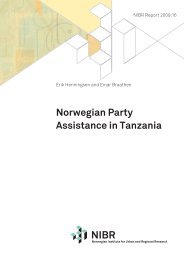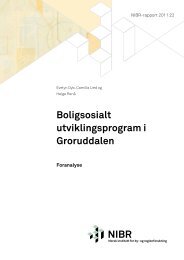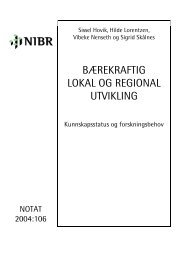http://www.tandfonline.com/page/terms-andconditions
The special importance of housing policy for ethnic minorities ...
The special importance of housing policy for ethnic minorities ...
- No tags were found...
You also want an ePaper? Increase the reach of your titles
YUMPU automatically turns print PDFs into web optimized ePapers that Google loves.
International Journal of Housing Policy 7Downloaded by [Norsk Institutt for By og] at 07:07 11 March 2013Housing policies vary much between Nordic countries in spite of their <strong>com</strong>mon backgroundas social democratic welfare states. In a <strong>com</strong>parison of housing policy instrumentsin the four countries (Lujanen, 2004), it was said that ‘surprisingly big differences’ werefound in implementation and in the means used. Similarly, another <strong>com</strong>parative study ofhousing policy in the four Nordic countries (Bengtsson et al., 2006, p. 12) concludes that theway housing policy has been implemented in the different countries shows such importantdifferences that one can talk about quite different housing systems: differences in policies,institutions and markets. Danish and Swedish housing policies are characterised by beingmore general and universalistic. In Norway and Finland there are, to a greater extent, specialpolicies for low-in<strong>com</strong>e groups regulated by means tests.Sweden has been the country that has put most weight on housing as a social goodwith equal housing possibilities for all (Turner & Whitehead 2002; Magnusson Turner,2010). Denmark also had strong social objectives for housing but not as pronounced asin Sweden. More weight has been placed on the market and less on state control. Earlier,Norway had a strong state control of housing finance with supply subsidies for all kinds oftenures, but this has been abolished since the 1990s. Policies in Norway have always beenmore selective and needs tests have been extensive. In Finland, housing policy, to a greaterextent than in the other three countries, has been seen as social policy for the weaker groupsin society. Housing policy has earlier been characterised as ‘provisional’ (Niva, 1989) oras ‘non-policy’ (Juntto, 1992). What is meant is that housing policy to a greater extenthas been a kind of ad-hoc policy adjusted to economic fluctuations and actual problemsappearing on the housing market.One of the reasons for the differences in the <strong>com</strong>position of the housing markets,shown in Table 2, is that political objectives concerning the desirability of different kinds ofhousing tenures have differed. Sweden is the only country that has had an explicit objectiveto give equal status to all tenures. In Norway, it has been an explicit political notion thathomeownership is the most desirable kind of housing for all. Rental housing is regarded asa temporary stage in the housing career. Denmark and Finland have not formulated politicalobjectives concerning tenures, but in practice their policies have been most favourable forowner-occupation.One of the key elements in housing policy, the provision of a social/public housingsector, has been carried out somewhat differently in the countries (see Table 2).Twenty yearsago Sweden had the largest social/public housing sector, but conversion into cooperativeshas reduced the sector to 14% of the housing stock. Finland has about the same amountof social/public housing, while Denmark has the largest sector (21%). In Norway, thesocial/public housing sector is very small, only about 5% of the stock.Table 2.Tenure <strong>com</strong>position of the housing markets.Denmark Finland Norway SwedenDistribution of dwellings on tenure,%Owner-occupied 53 59 62 52Cooperatives 7 1 14 18Private renting 19 14 19 15Social/public housing 21 16 5 14Other 10Total 100 100 100 100Source: Anderson et. al. 2010.
















